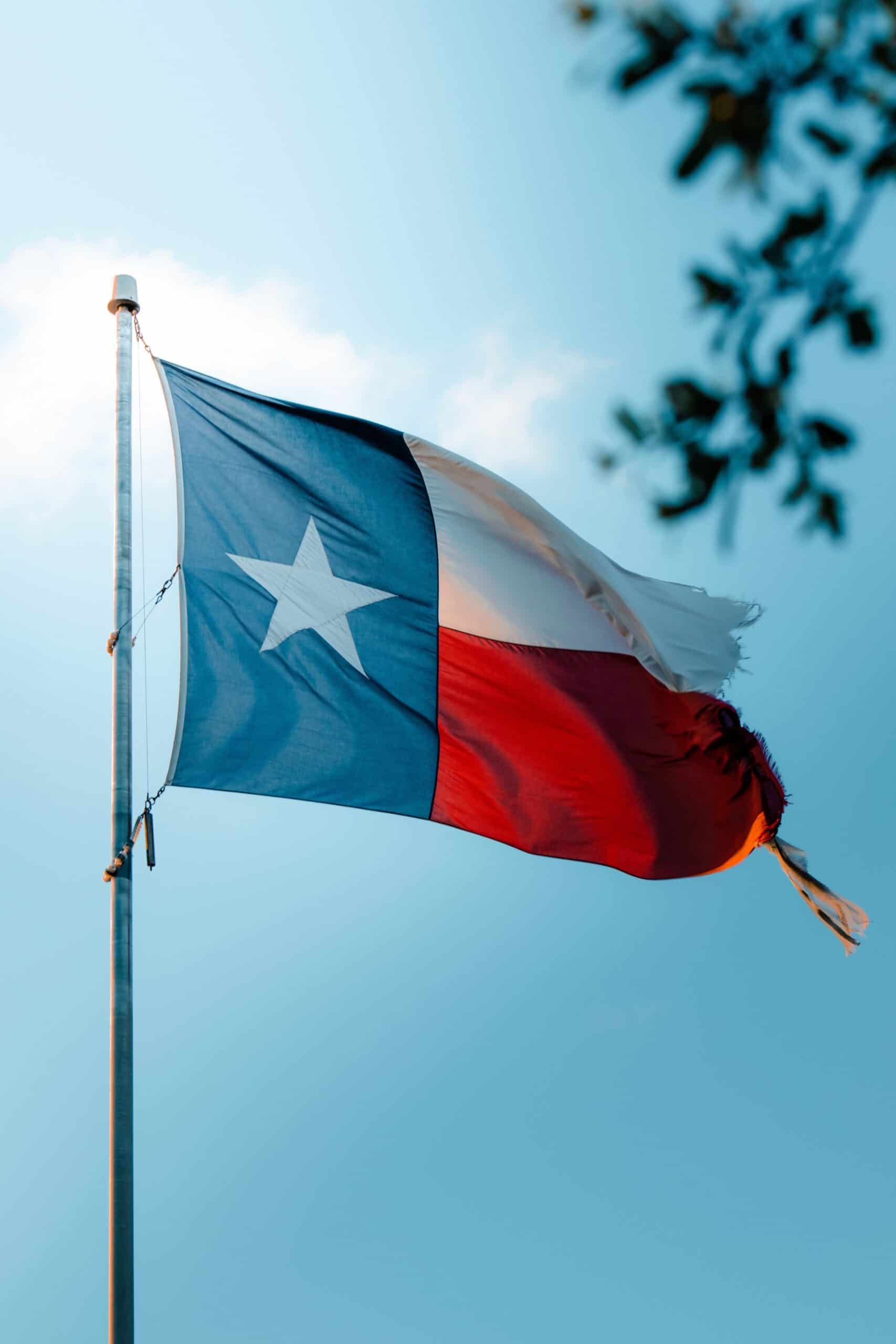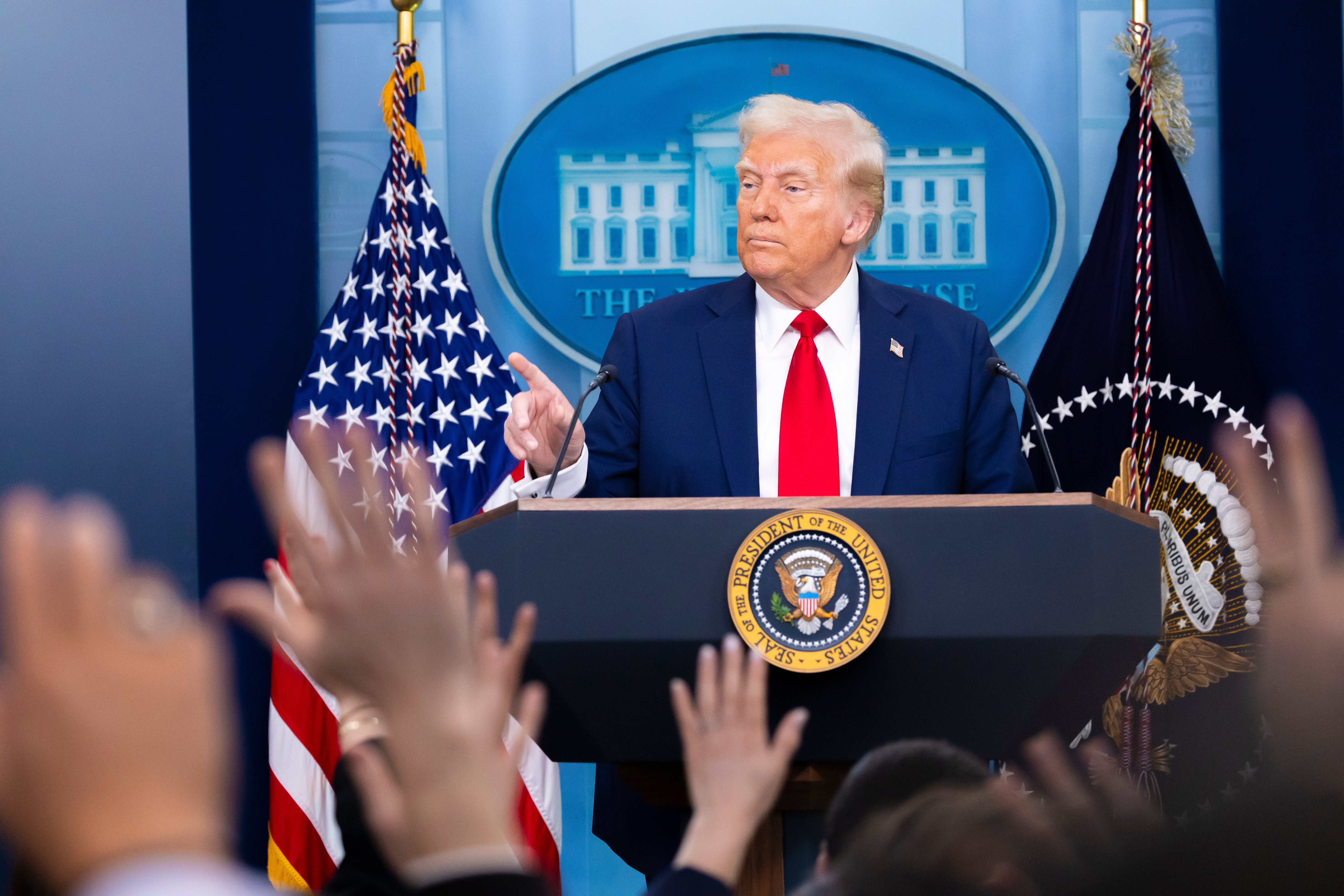Texas took over the national spotlight last week as it hosted the first primaries of the year on March 1 in preparation for the 2022 Midterms. The state has increasingly become a spending battleground for both parties, and we have already tracked $77.5M in political advertising in the state. In January and February 2022, we saw $41M in spending, more than three times that of the first two months of 2018 ($13M). This increased spending also coincided with heightened national attention. Here, we highlight six primaries we think are worth examining, three of which are poised for primary runoff elections this May.
TX Governor
The gubernatorial primary was the most expensive election in the Lone Star State, with spending totaling $17.9M. Campaigns spent 98.8% of that total, with a combined $17.7M, while Issue Groups only spent $207K. In the GOP primary, incumbent Greg Abbott’s campaign spent $11.6M while Don Huffines, a former Texas State Senator, spent 5.3M. Abbott outspent Huffines in every Texas market. Allen West spent the third most, totaling $271K. Abbott easily won the primary, receiving over 66% of the vote. In the Democratic primary, Beto O’Rourke, who represented Texas’ 16th congressional district from 2013 to 2019, was the only candidate to place ads. He spent $474K exclusively on digital media. He won the primary in a landslide, receiving 91% of the vote. Despite Abbott and O’Rourke winning their respective primaries handily, the Texas Governor primary was the seventh most expensive race across the country by the time it concluded last week. It saw higher spend totals than Senate races in Alabama, Wisconsin, Nevada, and North Carolina. We anticipate spending to ramp up heavily in preparation for the general election when Abbott and O’Rourke face off in November.
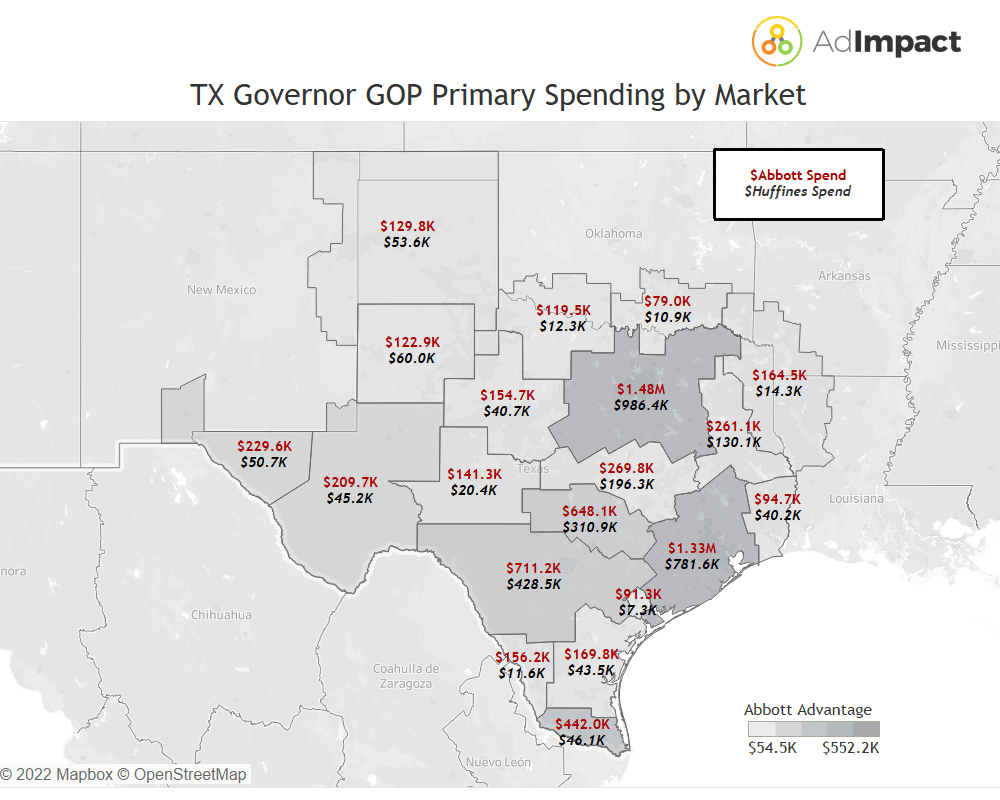
TX Attorney General
The second most expensive primary in Texas was for Attorney General, totaling over $15.2M. In the GOP primary, three campaigns spent over $3.5M each. Eva Guzman, a former member of the Texas Supreme Court, led in total spending with $5.9M. She was followed by two-term incumbent Attorney General Ken Paxton with $4.8M, and Texas Land Commissioner George P. Bush with $3.6M. Despite an endorsement from former President Donald Trump, Paxton failed to gain 50% of the vote, necessitating a runoff election. Bush placed second among challengers, meaning the two will square off on May 24.
TX CD-28
For the second year in a row, Jessica Cisneros challenged incumbent Henry Cuellar in a highly competitive Democratic primary. We saw considerable amounts of spending by advertisers supporting both candidates; $2.7M in support of Cuellar and $1.7M supporting Cisneros. Of the Cuellar expenditures, $1M was spent by the campaign and $1.7M was spent by Issue Groups. The Cisneros campaign spent $1.4M and received $300k in support from Issue Groups. While spending levels were small throughout 2021, spending increased around the November 2021 off-year elections and in the lead up to the March 1 TX CD-28 primary. Cuellar’s Ads focused on healthcare, border security, and opposing the Defund the Police movement. Cisneros’s Ads focused on Cuellar’s alleged issues with corruption and her support for Medicare for All. While Cuellar outperformed Cisneros in the primary, he failed to meet the 50% threshold needed to avoid a primary runoff. Cuellar received 48.4% while Cisneros received 46.9%. For the most part, Cuellar did better in rural areas and small towns while Cisneros did very well in San Antonio and its close suburbs. In Bexar County, which includes San Antonio, Cisneros defeated Cuellar 73%-21%. The TX CD-28 primary Runoff will take place on May 24, 2022, and we expect to continue to see high levels of spending from both candidates as this primary will likely be decided by just a few points.

TX CD-35
While the TX CD-28 Democratic primary is going to a runoff, the TX CD-35 Democratic primary will not. TX CD-35 sprawls from San Antonio to Austin along the I-35 Corridor. Congressman Lloyd Doggett (D), who currently represents TX CD-35, opted to run in the newly created TX CD-37 in this cycle. Without an incumbent, the two main contenders in the TX CD-35 primary were Austin City Councilman Greg Casar and State Representative Eddie Rodriguez. In addition to Casar’s campaign spending $219K, Issue Groups Justice Democrats and Working Families Party supported the candidate, spending $104K. The Rodriguez campaign spent $105k, meaning that advertising supporting Casar outspent advertising supporting Rodriguez by a 3-1 margin. Casar received 61% of the primary vote while Rodriguez only received 15%.
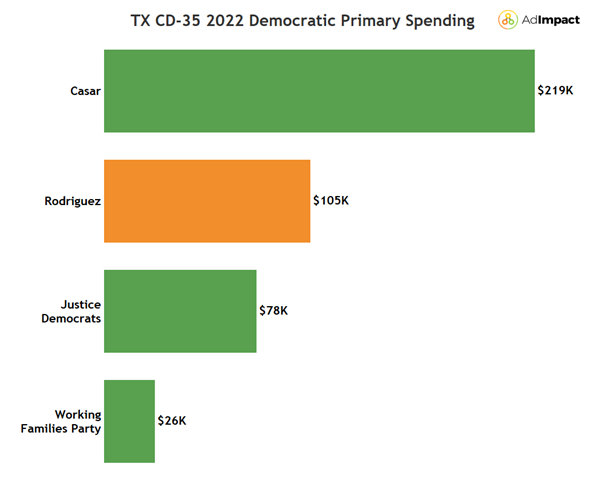
TX CD-03
Incumbent Van Taylor (R), who has been in office since 2019, faced four opponents in the TX CD-03 GOP primary. These opponents were Keith Self, Suzanne Cassimatis Harp, Rickey Williams, and Jeremy Ivanovskis. We only recorded spending from Taylor and Self. Overall, we recorded over $1.2M in advertising expenditure. Taylor spent over $829K and Self, a former Collin County Judge, spent almost $25K. Taylor’s ads emphasized his conservative voting record and allegiance to Trump. Issue Groups supporting Van Taylor spent almost $205K while Self saw nearly $225K in Issue Group support, all coming from a group called Defeating Communism. The election resulted in Taylor receiving 49% of votes and Self getting 27%, closely mirroring the spending breakdown seen for Taylor and Self. Taylor was around 800 votes away from the majority, which resulted in a planned May 24 Runoff. After primary results came in and the runoff was confirmed, Van Taylor admitted to having an affair and withdrew from the race. The runoff has since been cancelled and Keith Self will be the Republican nominee for the general election in November.
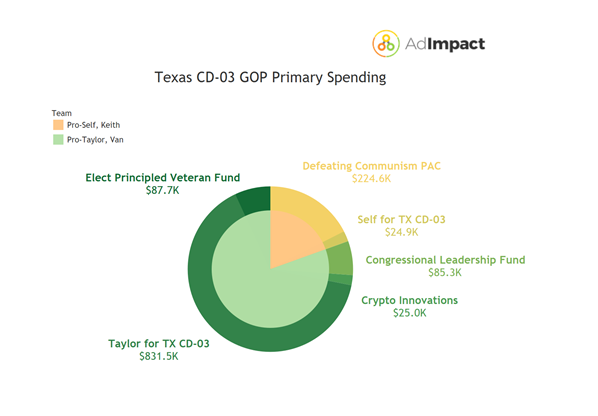
TX HD-12
In the race for TX HD-12, Republican incumbent Kyle Kacal, who is looking to serve a 6th consecutive term, faced two competitors in the GOP primary. His opponents were Ben Bius, a business owner from Huntsville, and Army veteran Joshua Hamm. Overall, we recorded just under $200K in spending. We recorded $126K in spending supporting Kacal and just over $74K supporting Bius. We did not record any spending for Hamm. Kacal’s ads focused on his priorities of fighting for rural Texan values and outlined his past accomplishments as a representative. Bius’s ads described his conservative values and included an endorsement from Texas Senator Ted Cruz. Kacal received 47.2% of the vote, Bius received 41.6% of the vote, and Hamm received 11.2% of vote. Since the primary election did not end in a candidate reaching a simple majority, a runoff is scheduled for May 24. We can expect continued spending from both Kacal and Bius leading up to the runoff.
Texas has already seen over $77.5M spent for 2022 races. With high-profile primary runoffs including Attorney General and TX CD-28 coming in May, we anticipate statewide spending to continue to grow. We are projecting that Texas will see a total of $372M spent by the conclusion of the general elections later this year. We anticipate that the gubernatorial election will be the most expensive at $65M. With $17.9M spent already in the primary, we expect the Abbott and O’Rourke campaigns and Issue Groups spending for them to easily meet that projection. For now, all eyes are on the upcoming high-profile primary runoffs that will strongly dictate the generals in November.

